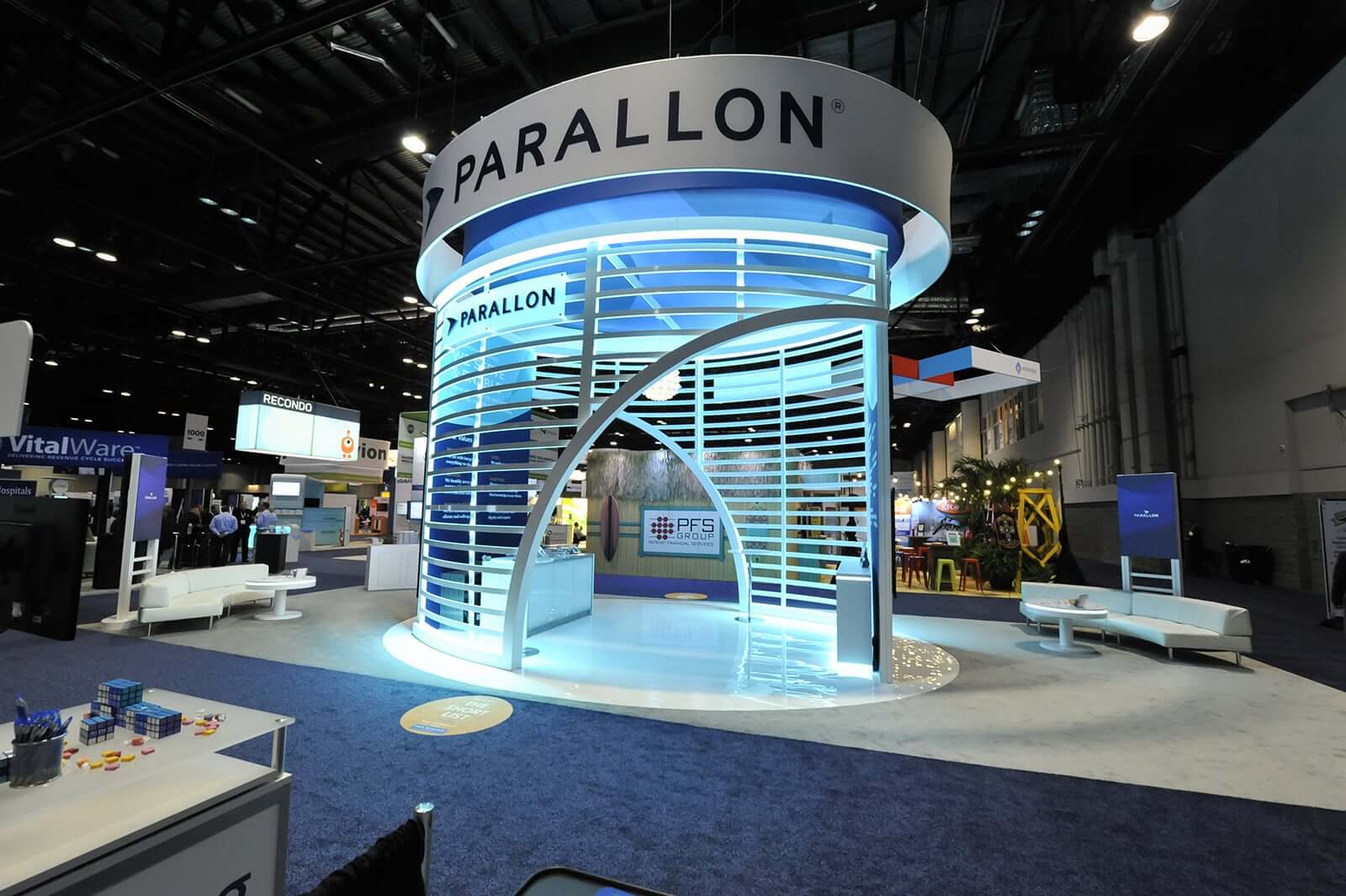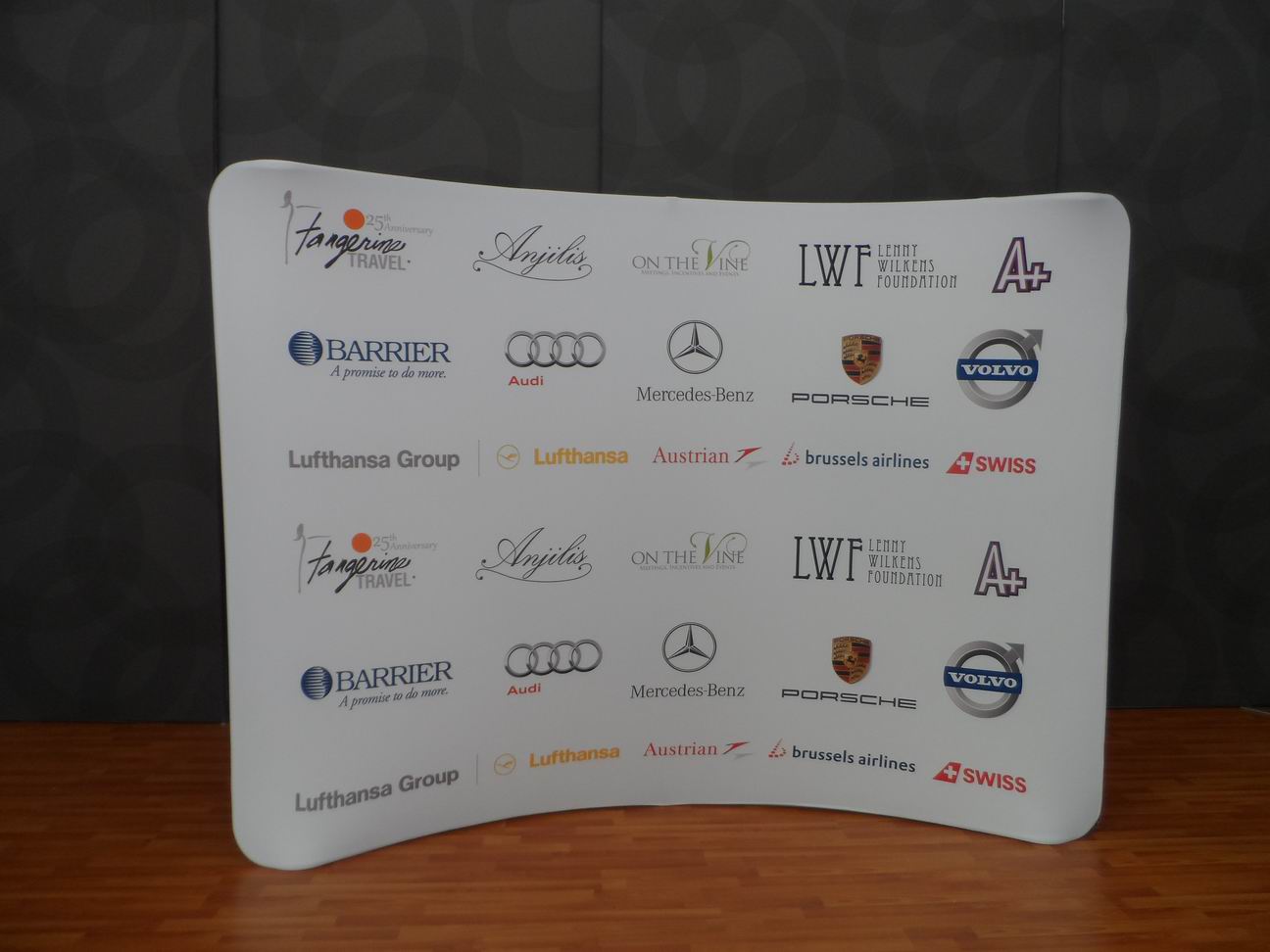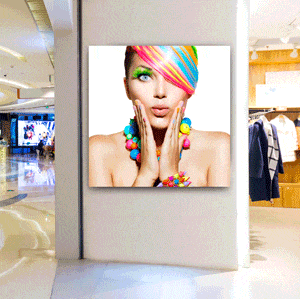Better Trade Show Banner Design – Your Guide to High Impact Banners
Your trade show banner design is critical in determining whether or not trade show attendees walk into your booth. The trade show banner serves three main purposes: attention-grabbing, brand awareness, and brand representation.
Research shows that 93% of customers decide based on how a company or product presents itself visually. Therefore, you must design a banner that creates a great impression of your business.
This article offers a comprehensive guide for designing your trade show banners, including guidelines for designing the elements in your banner, factors to consider, and useful tips for designing an effective trade show banner.

Key Elements in a Trade Show Banner Design
Messaging
The goal of messaging is to keep the text minimal while clearly communicating who you are as a brand. Pertinent information that must be included in your banner stands includes logo, company name, tagline, and contact information. When designing a banner for product display, ensure to include a clear image of the product.
Background
You can either design your trade show banners with a solid color background or a photo background. A solid background enhances the visibility of the text. If your banner content has images of people, it is best to use a solid background. The solid background is a good fit if the banner has a product image whose graphics have a lot of text.
On the other hand, a photo background works well if your trade show banners have minimum text and no product image. With a photo background, ensure that font color conspicuously contracts the background. Otherwise, the photo can take away attention from the text.
The best way to decide which type of background is most suitable is testing for the highest contrast between the background and the text.
Image
While 40% of businesses use text only in their prints, the human mind makes a deeper connection with images than texts. We tend to notice the images first before moving attention to the text. Therefore, it would be great to incorporate an image in your trade show banner design if it fits well with the overall design. Use high-resolution images to prevent pixilation when printed.
Color
The colors used in your trade show banners are key in ensuring your banner stands out. Color psychology studies reveal that the colors you use increase brand recognition by 80%. The studies further reveal that up to 90%of people make a subconscious decision about whether or not to engage with a business based on color. Moreover, certain colors evoke a particular emotion.
When deciding on which colors to use for your background and text, it is advisable to go with your brand colors to ensure brand consistency in your marketing materials. Integrate your brand colors across all your branding elements, including the logo, product design, tagline, background, and text.
Think through the primary emotion you would like to evoke in potential customers and incorporate the color that brings up that emotion in your trade show banner design. Keep in mind that too many colors can be more confusing to the customer as opposed to effectively grabbing their attention. The majority of businesses (up to 95%) use two colors in their branding and banner design, and the rest more than use more than two colors.
Fonts
Use fonts that are easy to read both up close and from a distance. For tabletop banners, use smaller fonts, while for backdrops and trade show banners, use larger fonts. Whenever possible, limit font types to a maximum of two. The minimum recommended font size for large and medium-size trade show banners is 70pt.

Factors To Consider When Designing Your Trade Show Banners
The following are crucial factors to consider when designing your trade show banner:
Printing Costs
Trade show banners printing costs will significantly affect your exhibition budget. Printing costs are dependent on the overall design, size, and the banner’s material. Research the various options available for banner size and materials and how much they would cost.
Generally, laminated and paper banners are costlier than vinyl and fabric banners. Also, the type of mounting will affect your overall banner set up cost. Find out with your printing company whether the cost of mounts is included in the overall printing costs to budget accurately.
Materials
The most common banner materials options include vinyl, fabric, and canvas.
Vinyl: Vinyl is the most common banner material as it is weather-resistant, durable, and easy to print on. You can choose between standard vinyl, heavy-duty, and mesh vinyl. Heavy-duty vinyl material is the most weather-resistant, fade-resistant, and fully waterproof hence is must suitable for repetitive use outdoors. On the other hand, mesh vinyl is porous and wind-resistant. It is a great option for outdoor banners, while a standard vinyl can be used for indoor banners.
Canvas. Canvas offers a non-gross, painted look of the graphics. Canvas banners are best suited for indoor use.
Fabric. Most fabric trade show banners are made from polyester, which is lightweight, wrinkle-resistant, and durable. Fabric banners are most suitable for indoor applications.
Types of Banners
There are numerous types of trade show banners to choose from. Here is an overview of the most common ones for you to consider:
- Tabletop retractable banners. These are relatively smaller sized banners that are placed on your event table. They are mainly used to draw attention to a particular product or a giveaway. Tabletop retractable banners are aimed at grabbing the attention of the attendees once they are at your booth. Therefore, they need not have very large graphics that might be distracting.
- Spring back banners. They are most suitable as a backdrop for your display table. Otherwise, if placed on top of the event table, they may obstruct the view of other display elements or the view of the staff.
- Floor-standing retractable banners. Retractable banners are convenient to use as they are portable and easy to assemble and disassemble. They also offer ample advertising space. They roll up like a window shade in reverse for easy setup. These types of banners are designed with graphic protection elements to ensure that the graphics are not distorted as the banner rolls up.
There are various size options for floor-standing retractable banners available. The smallest ones start at 17sq.feet, and the large ones are about 32sq. feet and 5 feet wide. The smaller ones can be set up on the side of your trade show booth in pairs, while larger ones can be used as the backdrop of your booth.

- Step and repeat banners. They are sophisticated, high-technology banners that allow you to resize or change graphics as your display needs change. Their sizes range between 13 and 64 square feet. They can serve as a backdrop in a small booth or as a banner in larger booths.
- Adhesive banners. They are designed to be stick-on banners that can be stuck on walls or other hard surfaces. Often, they are not reusable and are most ideal for permanent placement.
- Double-sided banners. These are not the most common type of banners in trade shows. However, they may be an ideal option if your booth is in the middle of the aisle. It will offer you visibility from either direction.
Banner Mounting and Stands
There is a wide range of banner stands to choose from, including retractable banner stands, non-retractable banners, bamboo banner stands, 3D banner stands, twist banner stands, aura backlit banner stands, and rotating banner stands.
Retractable banners are the most common as they are lightweight, compact, easy to set up, height adjustment, and affordable. Non-retractable banners include L-stands, X-stands, and telescopic stands.
If you are keen on non-metallic stands, then a bamboo banner stand is a great option. The 3D banner stands are applicable for double-sided banners, while twister banner stands offer a seamless and convenient way to position banners side by side. However, they can also be used for stand-alone banners.
The backlight banner stands from American Image typically have an aluminum frame for structural support and use backlighting to create contrast for better visibility and to highlight the content. As they say, oftentimes you only have seconds to attract attention, and backlighting helps to do that.
Motion also helps to attract attention. We offer motion in the backlit graphics with programmed LEDS, as used in our animation light box. These banner designs work to keep turning on and off the LEDS in patterns that simulate motion on the graphic.
We also offer trade show banner designs that use curved shapes to simulate motion, again trying to help catch the attention of attendees from different angles. They can be used for single and double-sided banners.
Size of the Banner
The ideal size of your trade show banners is mainly dependent on your venue space. Larger spaces require that you design larger banners and vice versa. Some trade show hosts may have banner size recommendations or restrictions. Therefore, it is a great idea to check in with them about any recommendations or restrictions they might have before beginning work on your trade show banner design.
The banner’s size is also dependent on the type of banner you prefer and its mounting mechanism. For instance, retractable banner stands have size specifications that you would have to adhere to.
With that said, the most common trade show banner sizes are as follows: 6×2 feet, 6×3 feet, 3×6 feet, and 2×6 feet. However, in most cases, you can work with a professional printing company to design custom-sized banners.
Tips for Designing Your Trade Show Banner
- Ensure brand congruence in your banner design. Keep the colors, images, fonts, and wording consistent across the various marketing materials that will be used at your exhibitor’s booth.
- Design with the target audience in mind. What do you want to notice first in your banner? Which emotions would you like to evoke? Is your primary audience male or female, younger or older? All these factors come into play, especially when deciding on the color and words to use.
- Position the most important information at the top of the banner. Attendees will mostly be reading your banner from top to bottom. You want to capture their attention immediately they start reading. You also want to communicate the most important information at the top of the banner. Furthermore, depending on where you position the banner, the lower parts may be obstructed by the event table or people passing by. The logo is one of the most recognizable brand elements in your marketing materials and should be positioned at the top for clear visibility.
- You may put up several trade show banners at your exhibition booth. For instance, you can have a large banner that serves as the backdrop, a medium-sized banner that serves as the display banner, and a product display banner. When using several banners, ensure that your company’s logo is in all the banners to reinforce your brand identity.
- You don’t have to fill all the space in your banner. Banners offer a lot of space to design on, but you do not have to fill all of the space with design elements. Keep it minimal and simple. Blank space is great for balancing the various design elements. It also improves the visibility of the elements without bombarding the customer with too much to see and process in a few seconds.
- Hire a professional for your banner design and printing. While you can DIY your trade show banner if you have a phone with excellent camera quality, some basic design skills, and someone you know who could print a banner for you, you must leave the design and printing of your tradeshow banner to a professional. You cannot afford to have misplaced elements or blurry images on your design. Or a banner made from low-quality material that rips ups in the middle of your exhibition. Take time to do your due diligence to find a reputable banner design and printing company to work with.
- Determine your core messaging for the trade show. Trade shows definitely improve your brand awareness. However, if you are a multifaceted business with different categories of products, you may choose to focus your message on one category. On the other hand, if you would like to drive sales for a given product, you can have some promotional banners for those products.
Your trade show banners design is pivotal in your exhibition booth set up, branding, and marketing efforts. Therefore, it should be well thought through. Determine the main purpose you want each banner to serve, hence its core message. Work with a reputable designer to develop high-quality graphics for the banner. Then have the banner printed on high-quality material.

